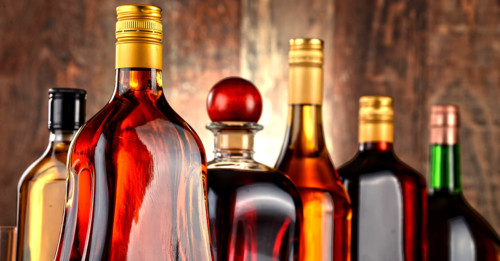Building a bar is a pretty personal thing. Sure, there are some basic everyone wants to have on hand, but your tastes determine what you’ll be stocking behind the bar. Not that you actually have to have a physical bar. A “bar” can refer to the stuff you stock in your liquor cabinet, fridge, freezer, even in a box under the bed. When we talk about a “building a bar” we’re really just referring to a slightly more thoughtfully curated selection of straight spirits or cocktail ingredients. To that end:
- Assuming you’ve secured a location for your bar, and have regular sources of ice and refrigeration, the first big step is figuring out what you like to drink. If you don’t have any sense of your preferences, or if you haven’t really tried many spirits before, it’s a much better idea to go to actual up-and-running bars to taste a few things, get a sense for what you like before you buy. Spirits—most decent, drinkable spirits—tend to run a bit more expensive.
- Next is to figure out what kind of bar you’re building—is it a spirits bar or a bar with cocktail capabilities? Do you like, say, Bourbon whiskeys and want to have more than a few on hand for sipping, or do you want to be able to whip up a batch of Gin Martinis to celebrate your new cocktail dress? Your goals should guide your shopping list.
- Speaking of shopping, it’s always good to do a little research before you buy. If you know a bottle that you like, great, start there. What is it about that spirit that you like? And where can you find more of it? The best way to figure this out is to better understand the spirit type and read a few product reviews online. Also, since you’re now interested in tasting spirits pretty seriously, write down what you like about a certain bottle or cocktail flavor profile. Once you have a sense for what you like—the caramel and vanilla of aged rum, the acidity and smooth mouthfeel of a Pisco Sour—you can look for it elsewhere. Same goes for stuff you hate: fruitiness? smokiness? bitterness? You’re buying, so if you hate it, avoid it.
- When buying another brand of a spirit you like, beyond tasting notes, you’ll want to pay attention to region. Regionality is often very connected to character in spirits. Think French Caribbean rum, Kentucky Bourbon, the six distinct regions of Scotch Whisky.
- If you’re going for more than spirits in your bar and want to actually be able to make cocktails, you’ll need a few extras. As with a spirits-only bar, you’ll need to know what you like to drink—do you want more options for tequila in your bar, do you prefer darker, stirred whiskey drinks, or would you like a bit of everything? Just like with a spirits bar, research first, and then, depending on what kinds of cocktails you’d like to be able to make, you’ll need to buy certain ingredients, things like bitters, liqueurs, syrups, fresh fruit (many cocktails use fresh citrus, and not just as a garnish), etc. The best way to figure out what kinds of extras you’ll need is by looking up the recipes of a handful of your favorite cocktails.
- Once you’ve got cocktail ingredients, you need a way to combine them. Again depending on the recipe, your drink might need to be shaken or stirred—that means you’ll need either a mixing glass for stirring or a shaker. The mixing glass is a widely available beaker-shaped container into which you’ll put your ingredients, plus ice, and stir them up with a cocktail spoon (a long-necked spoon, designed to glide easily against the rim of the glass). Shakers are also widely available—stainless steel shakers into which you’ll dump ingredients, plus ice, shake (looking as cool as possible), and strain. For either shaker or mixing glass, you’ll need a jigger—a stainless steel cocktail measurer that looks like two tiny metallic ice cream cones stuck together by the tip. Often, one side holds 1 ounce and the other holds ½ an ounce, but that can vary.
- And then there’s the ice itself. You’ll need access to a regular supply if you’re making cocktails, or if you take your spirits on the rocks. If you’re using ice only to shake or stir a drink, size matters a bit less, though bigger ice cubes will prevent too much dilution (unlike pebble or Scotsman ice, which is what a drink like a Mint Julep is served with). Because cocktail culture had itself a nice little renaissance recently, specialty ice is a bit more available. You can order trays and molds online at places like Amazon, Williams Sonoma, and Cocktail Kingdom. Just remember: larger cubes are good for slower dilution, for a stirred drink or even a shot on the rocks. Plus they look cool.
- As for what to drink your spirit or cocktail in, check out the best glassware here. Clear is better, since drinking spirits can also be a bit enjoyably showy.
- If socializing is among your bar-stocking goals, it’s always a good idea to stock lower ABV spirits (certain liqueurs, e.g.) as well as non-alcoholic options like cranberry juice, ginger ale, and anything more interesting you can find (specialty sodas, e.g.). The teetotalers may wanna hang too, and not just sip on water.
- And, of course, if you want to hang an old time picture above your bar staging area (it could be a liquor cabinet, a side table, or an actual bar, though most of us don’t have those), it’s always good to err on the side of dudes with big mustaches.
Need some more inspiration? Check out one the greatest home bars we’ve ever seen.
